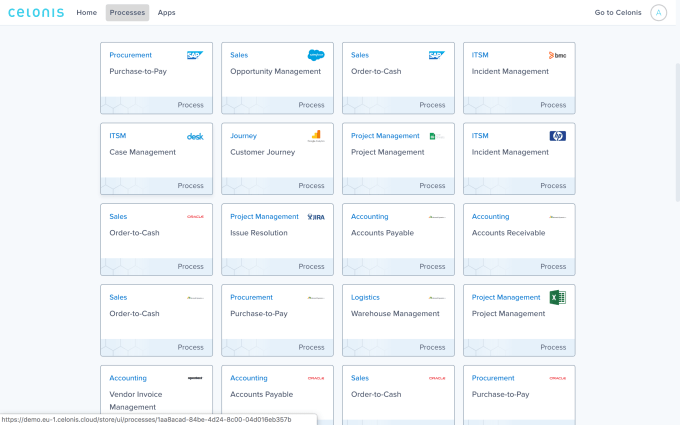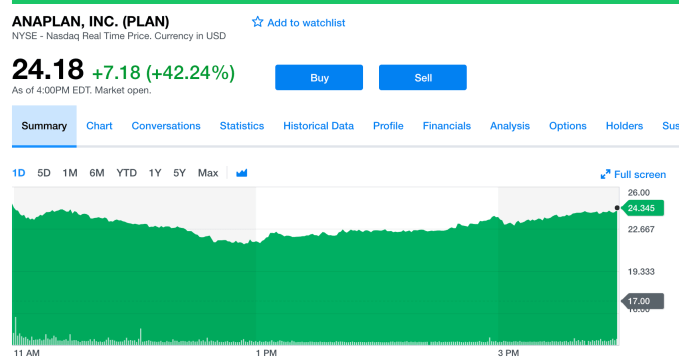TC
Auto Added by WPeMatico
Auto Added by WPeMatico
The charmingly outdated media player Winamp is being reinvented as a platform-agnostic mobile audio app that brings together all your music, podcasts and streaming services to a single location. It’s an ambitious relaunch, but the company behind it says it’s still all about the millions-strong global Winamp community — and as proof, the original desktop app is getting an official update as well.
For those who don’t remember: Winamp was the MP3 player of choice around the turn of the century, but went through a rocky period during Aol ownership (our former parent company) and failed to counter the likes of iTunes and the onslaught of streaming services, and more or less crumbled over the years. The original app, last updated in 2013, still works, but to say it’s long in the tooth would be something of an understatement (the community has worked hard to keep it updated, however). So it’s with pleasure that I can confirm rumors that substantial updates are on the way.
“There will be a completely new version next year, with the legacy of Winamp but a more complete listening experience,” said Alexandre Saboundjian, CEO of Radionomy, the company that bought Winamp (or what remained of it) in 2014. “You can listen to the MP3s you may have at home, but also to the cloud, to podcasts, to streaming radio stations, to a playlist you perhaps have built.”
“People want one single experience,” he concluded. “I think Winamp is the perfect player to bring that to everybody. And we want people to have it on every device.”
Now, I’m a Winamp user myself. And while I’ve been saddened by the drama through which the iconic MP3 player and the team that created it have gone (at the hands of TechCrunch’s former parent company, Aol), I can’t say I’ve been affected by it in any real way. Winamp 2 and 5 have taken me all the way from Windows 98 SE to 10 with nary a hiccup, and the player is docked just to the right of this browser window as I type this. (I use the nucleo_nlog skin.)
And although I bear the burden of my colleagues’ derisive comments for my choice of player, I’m far from alone. Winamp has as many as a hundred million monthly users, most of whom are outside the U.S. This real, engaged user base could be a powerful foot in the door for a new platform — mobile-first, but with plenty of love for the desktop too.
“Winamp users really are everywhere. It’s a huge number,” said Saboundjian. “We have a really strong and important community. But everybody ‘knows’ that Winamp is dead, that we don’t work on it any more. This is not the case.”
This may not come as a shock to Winamp users still plugged into the scene: Following years of rumors, an update to the desktop player leaked last month, bringing it from version 5.666 to 5.8. It was a pleasant surprise to users who had encountered compatibility problems with Windows 10 but had taken the “more coming soon” notice on the website with a massive grain of salt.
This kind of thing happens a lot, after all: an old property or app gets bought, promises are made and after a few years it just sort of fades away. So a free update — in fact, 5.8 eliminates all paid options originally offered in the Pro version — bringing a bucketful of fixes is like Christmas coming early. Or late. At any rate it’s appreciated.
The official non-leaked 5.8 release should come out this week (the 18th, to be precise), and won’t be substantially different from the one we’ve been using for years or the one that leaked. Just bug and compatibility fixes that should keep this relic trucking along for a few years longer.
The update to the desktop app is basically a good faith advance payment to the community: Radionomy showing they aren’t just running away with the property and slapping the brand on some random venture. But the real news is Winamp 6, which Saboundjian says should come out in 2019.
“What I see today is you have to jump from one player to another player or aggregator if you want to listen to a radio station, to a podcast player if you want to listen to a podcast — this, to me, is not the final experience,” he explained. It’s all audio, and it’s all searchable in one fashion or another. So why isn’t it all in one place?
The planned version of Winamp for iOS and Android will be that place, Saboundjian claims. On desktop, “the war is over,” he said, and between the likes of iTunes and web apps, there’s not much room to squeeze in. But mobile audio is fractured and inconvenient.
While Saboundjian declined to get into the specifics of which services would be part of the new Winamp or how the app would plug into, say, your Spotify playlists, your Google Music library, your Podcasts app, Audible and so on, he seemed confident that it would meet the needs he outlined. There are many conversations underway, he said, but licensing and agreements aren’t the main difficulty, and of course release is still quite a ways out. The team has focused on creating a consistent app across every platform you might want encounter mobile audio. A highly improved search will also play a role — as it ought to, when your media is all lumped into one place.
No word on whether it will retain its trademark intro upon installation — “WINAMP. It really whips the llama’s ass.” I certainly hope so.
This lack of specifics is a bit frustrating, of course, but I’m not worried about vaporware. I’m worried that other services will insist on the fragmented experience they’ve created that serves their interests better than ours. But if Radionomy can navigate these tricky waters and deliver a product even a little like what they’ve described, I’ll be thrilled (and my guess is tens of millions more will be, as well). And if not, well, we’ll always have the original.
Powered by WPeMatico
Celonis has been helping companies analyze and improve their internal processes using machine learning. Today the company announced it was providing that same solution as a cloud service with a few nifty improvements you won’t find on prem.
The new approach, called Celonis Intelligent Business Cloud, allows customers to analyze a workflow, find inefficiencies and offer improvements very quickly. Companies typically follow a workflow that has developed over time and very rarely think about why it developed the way it did, or how to fix it. If they do, it usually involves bringing in consultants to help. Celonis puts software and machine learning to bear on the problem.
Co-founder and CEO Alexander Rinke says that his company deals with massive volumes of data and moving all of that to the cloud makes sense. “With Intelligent Business Cloud, we will unlock that [on prem data], bring it to the cloud in a very efficient infrastructure and provide much more value on top of it,” he told TechCrunch.
The idea is to speed up the whole ingestion process, allowing a company to see the inefficiencies in their business processes very quickly. Rinke says it starts with ingesting data from sources such as Salesforce or SAP and then creating a visual view of the process flow. There may be hundreds of variants from the main process workflow, but you can see which ones would give you the most value to change, based on the number of times the variation occurs.

Screenshot: Celonis
By packaging the Celonis tools as a cloud service, they are reducing the complexity of running and managing it. They are also introducing an app store with over 300 pre-packaged options for popular products like Salesforce and ServiceNow and popular process like order to cash. This should also help get customers up and running much more quickly.

New Celonis App Store. Screenshot: Celonis
The cloud service also includes an Action Engine, which Rinke describes as a big step toward moving Celonis from being purely analytical to operational. “Action Engine focuses on changing and improving processes. It gives workers concrete info on what to do next. For example in process analysis, it would notice on time delivery isn’t great because order to cash is to slow. It helps accelerate changes in system configuration,” he explained.

Celonis Action Engine. Screenshot: Celonis
The new cloud service is available today. Celonis was founded in 2011. It has raised over $77 million. The most recent round was a $50 million Series B on a valuation over $1 billion.
Powered by WPeMatico
Truphone — a UK startup that provides global mobile voice and data services by way of an eSIM model for phones, tablets and IoT devices — said that it has raised another £18 million ($23.7 million) in funding; plus it said it has secured £36 million ($47 million) more “on a conditional basis” to expand its business after signing “a number of high-value deals.”
It doesn’t specify which deals these are, but Truphone was an early partner of Apple’s to provide eSIM-based connectivity to the iPad — that is, a way to access a mobile carrier without having to swap in a physical SIM card, which has up to now been the standard for GMSA-based networks. Truphone is expanding on this by offering a service for new iPhone XS and XR models, taking advantage of the dual SIM capability in these devicews. Truphone says that strategic partners of the company include Apple (“which chose Truphone as the only carrier to offer global data, voice and text plans on the iPad and iPhone digital eSIM”); Synopsys, which has integrated Truphone’s eSIM technology into its chipset designs; and Workz Group, a SIM manufacturer, which has a license from Truphone for its GSMA-accredited remote SIM provisioning platform and SIM operating system.
The company said that this funding, which was made by way of a rights issue, values Truphone at £386 million ($507 million at today’s rates) post-money. Truphone told TechCrunch that the funding came from Vollin Holdings and Minden Worldwide — two investment firms with ties to Roman Abramovich, the Russian oligarch who also owns the Chelsea football club, among other things — along with unspecified minority shareholders. Collectively, Abramovich-connected entities control more than 80 percent of the company.
We have asked the company for more detail on what the conditions are for the additional £36 million in funding to be released and all it is willing to say is that “it’s KPI-driven and related to the speed of growth in the business.” It’s unclear what the state of the business is at the moment because Truphone has not updated its accounts at Companies House (they are overdue). We have asked about that, too.
For some context, Truphone most recently raised money almost exactly a year ago, when it picked up £255 million also by way of a rights issue, and also from the same two big investors. The large amount that time was partly being raised to retire debt. That deal was done at a valuation of £370 million ($491 million at the time of the deal). Going just on sterling values, this is a slight down-round.
Truphone, however, says that business is strong right now:
“The appetite for our technology has been enormous and we are thrilled that our investors have given us the opportunity to accelerate and scale these groundbreaking products to market,” said Ralph Steffens, CEO, Truphone, in a statement. “We recognised early on that the more integrated the supply chain, the smoother the customer experience. That recognition paid off—not just for our customers, but for our business. Because we have this capability, we can move at a speed and proficiency that has never before seen in our industry. This investment is particularly important because it is testament not just to our investors’ confidence in our ambitions, but pride in our accomplishments and enthusiasm to see more of what we can do.”
Truphone is one of a handful of providers that is working with Apple to provide plans for the digital eSIM by way of the MyTruphone app. Essentially this will give users an option for international data plans while travelling — Truphone’s network covers 80 countries — without having to swap out the SIMs for their home netw orks.
orks.
The eSIM technology is bigger than the iPhone itself, of course: some believe it could be the future of how we connect on mobile networks. On phones and tablets, it does away with users ordering, and inserting or swapping small, fiddly chips into their devices (that ironically is also one reason that carriers have been resistant to eSIMs traditionally: it makes it much easier for their customers to churn away). And in IoT networks where you might have thousands of connected, unmanned devices, this becomes one way of scaling those networks.
“eSIM technology is the next big thing in telecommunications and the impact will be felt by everyone involved, from consumers to chipset manufacturers and all those in-between,” said Steve Alder, chief business development officer at Truphone. “We’re one of only a handful of network operators that work with the iPhone digital eSIM. Choosing Truphone means that your new iPhone works across the world—just as it was intended.” Of note, Alder was the person who brokered the first iPhone carrier deal in the UK, when he was with O2.
However, one thing to consider when sizing up the eSIM market is that rollout has been slow so far: there are around 10 countries where there are carriers that support eSIM for handsets. Combining that with machine-to-machine deployments, the market is projected to be worth $254 million this year. However, forecasts put that the market size at $978 million by 2023, possibly pushed along by hardware companies like Apple making it an increasingly central part of the proposition, initially as a complement to a “home carrier.”
Truphone has not released numbers detailing how many devices are using its eSIM services at the moment — either among enterprises or consumers — but it has said that customers include more than 3,500 multinational enterprises in 196 countries. We have asked for more detail and will update this post as we learn more.
Powered by WPeMatico
Penta, the German fintech startup that offers a digital bank account targeting SMEs, has raised €7 million in Series A funding. Backing the company once again is Inception Capital, with total funding now at €10 million since Penta was founded in May 2016.
Launched in Germany in December, and powered by Banking-as-a-Platform solarisBank (rather than holding a banking license of its own), Penta is designed to meet the banking needs of small to medium-sized businesses, including startups.
The premise is that SMEs are currently underserved by incumbent banks, including account opening being cumbersome and much more difficult than it should be and exorbitant fees charged for making payments or international money exchange.
Penta is also bringing some much-need innovation and features to the German business banking market.
One of those is multi-card support to make it easier to manage company expenses. Dubbed ‘Team Access,’ the recently launched feature lets business owners issue multiple MasterCards to employees who need to make purchases on a company’s behalf.
Each card is linked to a business’ Penta account but can have custom rules and permissions per card/employee, in terms of how much money can be spent and where. More broadly, the feature is designed to cut down the time and cost of expense management for SMEs.
Notably, I’m told that the Berlin-based challenger bank, which has already grown to a team of 40 and plans to get to 100 over the next year, is seeing 68 percent of new customers switching from their existing business bank account, with the remaining 40 percent newly incorporated businesses.
That suggests many German businesses aren’t satisfied with the banking status quo, even if they’ve already crossed the account opening hurdle. Specifically, I understand that multi-card support has been one of the main draw, the kind of feature that older banks with legacy software often struggle to deliver.
Powered by WPeMatico
Entrepreneur First (EF), the London-HQ’d company builder that invests in individuals “pre-team, pre-idea” to enable them to found new startups, is scaling up rapidly, as it promised to so. Already running programs in Paris, Berlin, London, Singapore, and Hong Kong, the so-called talent-first investor is setting up shop in Bangalore, India.
Although referred to as the “Silicon Valley of India,” Bangalore fits the EF bill quite well in terms of being a tech hub with latent potential, especially when measured by the small number of truly international startups it has produced. What’s also interesting — and something EF co-founder Matt Clifford noted on a brief call with me on Friday — is that India has long-been a source for tech talent generally but this has often been an export industry, spanning prominent leaders of major U.S. tech companies, right down to traditional development outsourcing. “It’s out chance to help reverse the brain drain,” is one way that Clifford framed it.
With that said, EF also notes that, according to Startup Genome, Bangalore’s startup ecosystem is valued at $19 billion, with an estimated 1,800-2,300 active tech startups. “The past decade has seen it shift from a purely skill-based factory model to a more startup mindset. There is a genuine interest in tech and an ability to attract highly skilled tech workers,” says the company builder.
To that end, EF will invest around $55,000 in each of the companies developed during its bi-annual Bangalore program, while also providing cohort members a monthly stipend of $2,500 as they develop their startup ideas in the first three months. Segments that EF will primarily focus on include defensible technology, AI, machine learning, and robotics, in addition to any opportunities spotted for deep tech consumer companies in India. Graduating startups from EF Bangalore will pitch to “leading regional and global investors” at Investor Day in Singapore next July, alongside counterparts from EF’s Hong Kong and Singapore programs.
Meanwhile, the latest EF expansion follows a $12.4 million funding round in 2017 led by Silicon Valley’s Greylock Partners, which also saw Greylock’s Reid Hoffman join the company builder’s board. The capital — to be used for operational purposes and separate from EF’s multiple investment funds — was raised to enable EF to scale its program in multiple tech startup/academic hubs around the world, and where it deemed the EF “secret sauce” can bring the most value. (Separately, I’m hearing EF is on the verge of closing a new, quite large investment fund.)
At the time of Greylock’s backing, Hoffman told TechCrunch he could see the company builder expanding to “20 or 30 or 40 cities, maybe even 50“. Having now reached six cities, that is starting to look a lot less lofty, even if it is far from proven how smooth scaling a company builder in the image of EF can be.
Powered by WPeMatico
The app for hiking enthusiasts just secured a big round of capital that will help it map more trails worldwide.
AllTrails has raised $75 million, led by Spectrum Equity, which has taken a majority stake in the company in the process. Founded in 2010, AllTrails raised a small amount of capital years ago from investors, including 2020 Ventures and 500 Startups. It was also part of AngelPad’s inaugural accelerator class. This is its first sizeable round of equity financing.
AllTrails provides what it calls an “outdoors platform” that includes crowdsourced reviews of trails from its community of 9 million avid hikers, mountain bikers and trail runners in more than 100 countries. It also provides detailed trail maps and other content tailor-made for outdoorsy folk. The company says its app has been downloaded more than 12 million times.
AllTrails was founded by Russell Cook, who has since left to launch another fitness tech startup called FitOn. The company is now led by Jade Van Doren, who joined as CEO in September 2015.
“I grew up camping in the Sierras with my grandfather and backpacking up there,” Cook told TechCrunch. “I looked around the space and it felt like there was a lot of room to build something meaningful that would help people find places to get outdoors and feel safe once they are out there.”
“I got really excited about doing that and we’ve made a lot of progress toward those goals,” he added. “I enjoy waking up in the morning and knowing what we are building is helping people live healthier and more active lifestyles.”
Cook said the business is cash flow positive and wasn’t seeking a venture capital infusion when Spectrum approached. He says their expertise in the consumer space — the firm also has investments in Ancestry, WeddingWire and several others — will be a big value-add for AllTrails.
In addition to expanding overseas, the company will use the capital to hire aggressively.
As part of the deal, Spectrum’s Ben Spero and Matt Neidlinger will join AllTrails’ board of directors.
Powered by WPeMatico
In a letter addressed to Canadian Prime Minister Justin Trudeau, Senators Mark Warner and Marco Rubio make a very public case that Canada should leave Chinese tech and telecom giant Huawei out of its plans to build a next-generation mobile network.
“While Canada has strong telecommunication security safeguards in place, we have serious concerns that such safeguards are inadequate given what the United States and other allies know about Huawei,” the letter states. The senators warn Canada to “reconsider Huawei’s inclusion in any aspect of Canada’s 5G development, introduction, and maintenance.”
The outcry comes after the head of the Canadian Centre for Cyber Security dismissed security concerns regarding Huawei in comments last month. The Canadian Centre for Cyber Security is Canada’s designated federal agency tasked with cybersecurity.
Next generation 5G networks already pose a number of unique security challenges. Lawmakers caution that by allowing companies linked to the Chinese government to build 5G infrastructure, the U.S. and its close allies (Canada, Australia, New Zealand and the U.K.) would be inviting the fox to guard the henhouse.
As part of the Defense Authorization Act, passed in August, the U.S. government signed off on a law that forbids domestic agencies from using services or hardware made by Huawei and ZTE. A week later, Australia moved to block Huawei and ZTE from its own 5G buildout.
Due to the open nature of intelligence sharing between the U.S. and its closest allies, the Canadian government would be able to obtain knowledge of any specific threats that substantiate the U.S. posture toward the Chinese company. “We urge your government to seek additional information from the U.S. intelligence community,” the letter implores.
Powered by WPeMatico
You might think that Anaplan CEO, Frank Calderoni would have had a few sleepless nights this week. His company picked a bad week to go public as market instability rocked tech stocks. Still he wasn’t worried, and today the company had by any measure a successful debut with the stock soaring up over 42 percent. As of 4 pm ET, it hit $24.18, up from the IPO price of $17. Not a bad way to launch your company.

Stock Chart: Yahoo Finance
“I feel good because it really shows the quality of the company, the business model that we have and how we’ve been able to build a growing successful business, and I think it provides us with a tremendous amount of opportunity going forward,” Calderoni told TechCrunch.
Calderoni joined the company a couple of years ago, and seemed to emerge from Silicon Valley central casting as former CFO at Red Hat and Cisco along with stints at IBM and SanDisk. He said he has often wished that there were a tool around like Anaplan when he was in charge of a several thousand person planning operation at Cisco. He indicated that while they were successful, it could have been even more so with a tool like Anaplan.
“The planning phase has not had much change in in several decades. I’ve been part of it and I’ve dealt with a lot of the pain. And so having something like Anaplan, I see it’s really being a disrupter in the planning space because of the breadth of the platform that we have. And then it goes across organizations to sales, supply chain, HR and finance, and as we say, really connects the data, the people and the plan to make for better decision making as a result of all that,” he said.
Calderoni describes Anaplan as a planning and data analysis tool. In his previous jobs he says that he spent a ton of time just gathering data and making sure they had the right data, but precious little time on analysis. In his view Anaplan, lets companies concentrate more on the crucial analysis phase.
“Anaplan allows customers to really spend their time on what I call forward planning where they can start to run different scenarios and be much more predictive, and hopefully be able to, as we’ve seen a lot of our customers do, forecast more accurately,” he said.
Anaplan was founded in 2006 and raised almost $300 million along the way. It achieved a lofty valuation of $1.5 billion in its last round, which was $60 million in 2017. The company has just under 1000 customers including Del Monte, VMware, Box and United.
Calderoni says although the company has 40 percent of its business outside the US, there are plenty of markets left to conquer and they hope to use today’s cash infusion in part to continue to expand into a worldwide company.
Powered by WPeMatico
Researchers at Indiana University have confirmed that stringent password policies – aside from being really annoying – actually work. The research, led by Ph.D. student Jacob Abbott, IU CIO Daniel Calarco, and professor L. Jean Camp. They published their findings in a paper entitled “Factors Influencing Password Reuse: A Case Study.”
“Our paper shows that passphrase requirements such as a 15-character minimum length deter the vast majority of IU users (99.98 percent) from reusing passwords or passphrases on other sites,” said Abbott. “Other universities with fewer password requirements had reuse rates potentially as high as 40 percent.”
To investigate the impact of policy on password reuse, the study analyzed password policies from 22 different U.S. universities, including their home institution, IU. Next, they extracted sets of emails and passwords from two large data sets that were published online and contained over 1.3 billion email addresses and password combinations. Based on email addresses belonging to a university’s domain, passwords were compiled and compared against a university’s official password policy.
The findings were clear: Stringent password rules significantly lower a university’s risk of personal data breaches.
In short, requiring longer passwords and creating a truly stringent password policy reduced fraud and password reuse by almost 99%. Further, the researchers found that preventing users from adding their name or username inside passwords it’s also pretty helpful. Ultimately, having a stringent password policy is far better than have none at all. It’s a no-brainer but it could be an important data point for your next tech project.
Powered by WPeMatico
AI-powered photo management app Zyl is going back to the drawing board with a streamlined, more efficient redesign. The app is now focused on one thing only — resurfacing your old memories.
Taking photos on a smartphone is now a daily habit. But what about looking back at photos you took one year, three years or even eight years ago? It can pile up quite quickly. Zyl thinks there’s emotional value in those long-forgotten photos.
Before this update, Zyl helped you delete duplicates, create smart photo albums based on multiple criteria and collaborate on photo albums. In other words, it was a utility app.
But when the company started talking with some of their users, they realized that one feature stood out and had more value than the rest.
Applying those AI-powered models to your photo library is a great way to find interesting photos. But nobody was really looking at them.
When you open the app, you get a view of your camera roll with your last photos at the bottom. There’s also a big green button at the bottom. When you tap on it, Zyl creates a satisfying animation and unveils an important photo.
If you took multiple photos to capture this moment, the app stitches together those photos and create a GIF. You can then share this Zyl with a friend or family member.

But the true magic happens if you try to get another Zyl. You have to wait 24 hours to unlock another photo. The next day, the app sends you a notification when your photo is ready. You can always open the app again and look at your past Zyls in a new tab with your most important photos.
Unlike Timehop or Facebook’s “On This Day” feature, Zyl doesn’t look at your social media posts and focuses on your camera roll. Zyl isn’t limited to anniversaries either.
Just like before, Zyl respects your privacy and leaves your photos alone. They’re never sent to the company’s server — Zyl uses the same photo database as the native one on your iPhone or Android phone so it doesn’t eat up more storage.
Over time, the app could give you more options by leveraging facial recognition and the intrinsic social graph of your photo library. Maybe you want to see more photos of your brother as his wedding is coming up.
And that notification can be a powerful nudge. I keep opening the app and sharing old photos. Zyl is a good example of the combination of something that you care about combined with an element of surprise.

Powered by WPeMatico